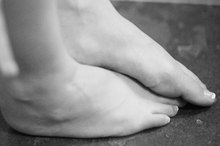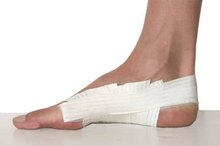What does fact checked mean?
At Healthfully, we strive to deliver objective content that is accurate and up-to-date. Our team periodically reviews articles in order to ensure content quality. The sources cited below consist of evidence from peer-reviewed journals, prominent medical organizations, academic associations, and government data.
- The National Institutes of Health: Experience with Keller Bunionectomy
- The National Institutes of Health: Experience with Keller Bunionectomy
The information contained on this site is for informational purposes only, and should not be used as a substitute for the advice of a professional health care provider. Please check with the appropriate physician regarding health questions and concerns. Although we strive to deliver accurate and up-to-date information, no guarantee to that effect is made.
Types of Bunion Surgery
Foot problems can be aggravating--it seems that, if the feet hurt, everything else hurts. Foot conditions can cause trouble with standing, walking, running and can be a source of difficulty with everyday life. A study by the American Orthopedic Foot and Ankle Society found that 88 percent of U.S. women wear shoes that are too small, and 55 percent of those women have bunions as a result. Several surgeries exist to help treat these problems.
If you are experiencing serious medical symptoms, seek emergency treatment immediately.
The Keller Procedure
A Keller bunionectomy typically involves surgical removal of the cartilage surface and a portion of the base of the bone in the big toe, called the proximal phalanx, which comes into contact with the first large bone in the foot, called the first metatarsal 5. The joint that these two bones form is called the first metatarsal-phalangeal joint. A study conducted by Drs. Marc and Edward Rankin of Washington, D.C., concluded that this procedure is a successful treatment option for chronic arthritis pain in the great toe joint, if performed on the right patient for the right reasons. In cases of severe arthritis, or for patients whose condition or other factors such as age or mobility status prohibit more complex foot surgery, the Keller procedure is a simple way to relieve severe arthritis pain.
- A Keller bunionectomy typically involves surgical removal of the cartilage surface and a portion of the base of the bone in the big toe, called the proximal phalanx, which comes into contact with the first large bone in the foot, called the first metatarsal 5.
The Silver Procedure
What Is a Saddle Bone?
Learn More
The Silver bunionectomy typically involves removal of the bony prominence, or spur, that exists along the medial or inner portion of the joint of the big toe. This spur forms as a result of chronic pressure from factors including ill-fitting shoes. Constant rubbing and pressure cause the foot to produce excess bone, called an exostosis, at the pressure site. The Silver procedure is a simple, successful way to treat bunion formation in patients who do not display any associated angular deformity of the foot.
- The Silver bunionectomy typically involves removal of the bony prominence, or spur, that exists along the medial or inner portion of the joint of the big toe.
- The Silver procedure is a simple, successful way to treat bunion formation in patients who do not display any associated angular deformity of the foot.
The McBride Procedure
The McBride bunionectomy is an extension of the simpler Silver procedure. While the McBride technique includes and duplicates the Silver bunionectomy, it has additional steps. These additional steps include transferring a small tendon from the base of the big toe to the first metatarsal bone in the foot. This transfer aims to solve the angular deformity of the foot that causes widening and contributes to angulation of the big toe. The procedure improves general alignment of the foot and big toe. In 1991, researchers Mann and Pfeffinger reviewed a large population who underwent McBride procedures. In their study, they found a 92 percent patient satisfaction rate after the procedure, with 10 percent being able to wear any type of shoe after surgery. The researchers concluded that the McBride procedure is an acceptable procedure, but it should be considered in a limited population demonstrating mild to moderate foot deformities; because:
- of these limitations
- its popularity
- frequency of use has fallen victim
- over the years
- to the more popular Austin procedure
- The McBride bunionectomy is an extension of the simpler Silver procedure.
- This transfer aims to solve the angular deformity of the foot that causes widening and contributes to angulation of the big toe.
The Austin Procedure
Tips for Relieving MTP Joint Pain
Learn More
The Austin bunionectomy involves the removal of the exostosis, or bony prominence along the inner border of the big toe joint. It also creates a cut in the bone, called an osteotomy, just beneath the metatarsal head, or the round joint head of the bone. The cut is in a V-shape called a chevron. This osteotomy enables the head of the metatarsal bone to be slid laterally, or toward the little toe. The combination of removing the bone spur and cutting and sliding the head of the first metatarsal bone eliminates the spur and reduces the angular deformity of that bone and the big toe, effectively narrowing the foot. Reducing the angle and narrowing the foot improves alignment and eliminates the pressure point in the area where the bunion formed in the first place.
- The Austin bunionectomy involves the removal of the exostosis, or bony prominence along the inner border of the big toe joint.
- The combination of removing the bone spur and cutting and sliding the head of the first metatarsal bone eliminates the spur and reduces the angular deformity of that bone and the big toe, effectively narrowing the foot.
Related Articles
References
- The American Association of Orthopedic Surgeons: Bunion Surgery
- Foot Hyper Book.com: Hallux Valgus
- Bunion Surgery.com: Bone Procedures
- The Podiatry Network: Bunion Surgery, Distal Head Procedures
- The National Institutes of Health: Experience with Keller Bunionectomy
- Besse JL. Metatarsalgia. Orthop Traumatol Surg Res. 2017;103(1S):S29-S39. doi:10.1016/j.otsr.2016.06.020
- Espinosa N, Brodsky JW, Maceira E. Metatarsalgia. J Am Acad Orthop Surg. 2010;18(8):474-85. doi:10.5435/00124635-201008000-00004
- Espinosa N, et al. Metatarsalgia. J Am Acad Orthop Surg. 2010;18:474-85.
Resources
Writer Bio
Ken Chisholm is a freelance writer who began writing in 2007 for LIVESTRONG.COM. He has experience in health care, surgery, nursing and orthopedics as an orthopedic physician assistant and a registered nurse. He holds a bachelor's degree in business from the University of Findlay, Ohio.









